
basics and general formats: Surround Sound
The A-Chain is the part of the cinema reproduction system from the audio playback system (magnetic tape, optical film or any other) to the ‚Main Fader’ input. The main fader is the control device for the general playback level in the motion picture theatre.
All parts in the signal chain after the main fader is called the B-Chain. This are equalizers, power amplifiers, crossover networks and loudspeakers. The sound transmission through the projection screen and the auditorium acoustics are also parts of the B-Chain.

Optical soundtracks were the first method to put audio on film material. The optical soundtrack is still today the standard for audio transmission in movie theatres (analog and digital).
The analog optical sound track is an audio stereo waveform printed parallel to the images in an opaque area on the side of the celluloid material. This can be Dolby A or Dolby SR, there the surround channels are matrixed into. Because light from the projector is directed onto the sound track, variations in the width of the tracks are detected by a solar cell, which converts the light into an electrical waveform. The soundtrack is printed photographically on the film with the images. This method is very durable and the sound track is as long lasting as the images itself.
In a mono print (mono cinema sound) there are still two tracks, both identical with the same content. A stereo track has the left and right track on the two sound tracks. With the matrixed surround formats the surround signal is modulated on the two tracks and will be extracted by a certain circuitry.
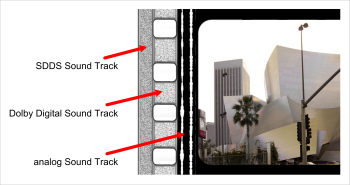
The front loudspeaker systems (two-way, three-way or four-way systems full range inclusive low bass) are normally installed in a sound baffle. This sound baffle is also a part of the THX recommendations. For larger cinemas a five channel setup is necessary to ensure a smooth coverage over the entire screen width.
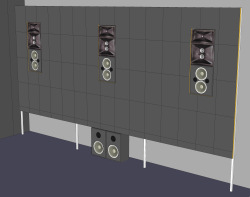 |
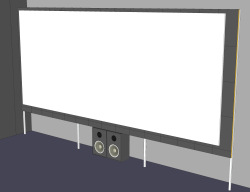 |
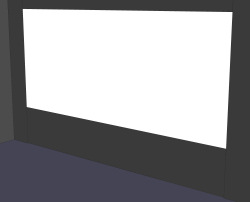 |
| L,C,R loudspeakers installed in sound baffle ('THX baffle') |
perforated screen in front of loudspeakers | masking system around screen motorized for different movie formats |
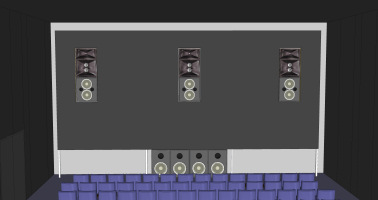 |
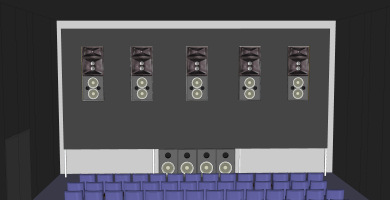 |
| front loudspeakers L - C - R | front loudspeakers L - CL - C - CR - R |
The front loudspeaker channels should be installed in a height of about 2/3 of the cinema screen and should be angled to the ear height of the seats in about 2/3 of the audience area. This slight angle also prevents reflections between the perforated screen and the speaker itself (a non-angled speaker could create standing waves between the speaker surface and the screen). The outside left and right speakers should be slightly angled to the centre of the room.

SMPTE RP 200-2002 specifies the levels of speaker systems for cinema and for monitoring. For film each channel of the surround system (front, center, surround and LFE) should output a sound pressure level of 85 dB(C)-slow reading- at standard fader settings. The relative sound pressure level difference between channels should be within +/- 0,5dB. See below "Level Measurement".
The maximum sound pressure level that could be output of the sound system (each individual speaker) should be up to 105 dB without amplifiers overloading or clipping.
The LFE channel is set to be 10 dB higher than the master channels (see below) to achieve the same measured listening level. The subwoofer channel, measured with wide-band pink noise on a realtime analyser (RTA) should show 10dB of in-band gain compared with the main channels. See below "LFE, Subwoofer".
The surround speaker channels are set individually to -3dB compared to the master channels. See below "Surround Channels".
All movies should be presented at these above mentioned standard fader settings with a SPL of 85 dB(C). Sometimes loud trailers may need compensation downwards but normally standard level should be executed all time. BUT, often this is felt as too loud and in many theatres the standard fader level is set to 79dB(C), -6dB down from the recommendations to create a more comforting listening level.
Channel equalization must be executed before (!) the channel levels are set:
Equalization: The electroacoustic response of the B-Chain is measured as an average of a sufficient number of measurements throughout the audience area. The measurement is done as a comparison of the frequency response to a linear pink noise input signal at the main fader input (usual signal input of the B-Chain). The used pink noise should be wide-band pink noise from 25 Hz to 20 kHz with a tolerance of +/- 0.5 dB.
See SMPTE RP 200-2002, SMPTE 202-1998.
This 'old-fashion' RTA measurement is definitely not sufficient for todays sound reproduction needs but because of the historical evolution of cinema sound and the large number of installed cinemas all over the world, it is very difficult to change setup procedures without creating big confusion. Sound reproduction in cinemas was already standardized in the 1930s and changed slowly since. RTA measurements cannot distinguish between the first arrival of direct sound and the built-up reverberation in the room. But listening to a sound system, our hearing-brain system psychoacoustically differentiates very well between these parts of the received sound. Reverberation and reflections are received in a very different way than the first wave front of direct sound from the loudspeakers.
In the 1970s the so-called "X-Curve" was developed by Ioan Allen of Dolby Laboratories. The only available measurement systems were RTA-type devices that show sound pressure level on individual frequency bands (usually 1/3 octave). With carefull equalization and control via the RTA measurement cinema loudspeaker channels were adjusted for a wide and flat frequency response (within the possible limits).
The X-Curve was standardized by ISO sand SMPTE and the standards today are ISO 2969 and SMPTE 202M-1998. This standardized frequency curve suggests a favorable average response curve measured at a number of positions in the room. The measurement shall be executed with wideband pink noise fed in at the main fader input of the cinema sound system and measured with the fully installed system including the perforated screen, individually for each channel. The curve shall be flat between about 60Hz and 2kHz with a roll off below 60 Hz and above 2 kHz with about 3 dB/octave. Above 10 kHz the roll off shall be 6 dB/octave. For different room sizes corrections in the high frequency slope are suggested (smaller rooms with less attenuation to the high frequency range).
Because pink noise and an RTA measurement are often very critical for speaker measurements in rooms with the involved room acoustic the X-Curve cannot ensure and cannot indicate a correct set up frequency response of the speaker channels and cannot ensure a 'flat' frequency response for any of the listeners in the cinema. Todays sophisticated measurement tools (TEF, FFT) are able to distinguish precisely between the different part of the sound response measured in the room and can guaranty an optimum in the frequency response perceived by the listener.
The upper roll-off in the X-Curve was intended to represent the typical high frequency roll off happening by installing speakers in large rooms. To set up a speaker system reproducing pink-noise and be measured in some distance a flat frequency curve would result in a much too high increase of the high frequency range and finally in a much too bright sound. The mis-proportion between low and high frequency content in the RTA measurement is caused by the energy-frequency relation of the built-up reverberation in the room. Low and mid frequency reverberation is always much higher than high frequency reverberation (air absorption within the late part of the reverberation field). The RTA measurement adds the reverberation field to the direct sound of the speaker resulting in a curve with a roll-off in the high frequency range.
The low frequency roll-off was taken from the average frequency response of good sounding theatres at the time. Because dubbing rooms etc. incorporate the same X-Curve, the missing energy is easily compensated in the film mix already. By using the X-Curve in a majority of theatres a more or less satisfactory general response curve could be ensured.
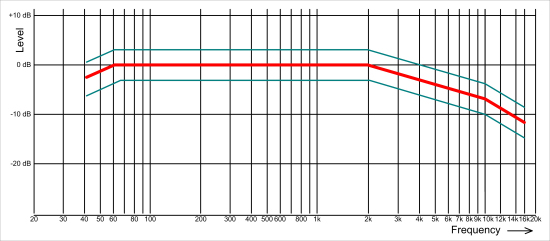 |
| the X-Curve, measured with wide-band pink noise |
One problem with the RTA measurement in the very low frequency range is that it doesn't take room modes and other anomalies into account. In the very low frequency range the 1/3 octave resolution of a classical RTA measurement system is much too wide even discover these effects. As a result each cinema could sound different and the impact and characteristic sound low frequency content and sound effects could not be guarantied to be as intended.
The next large problem is the added tolerance field. It was intended to not exclude speaker systems or rooms because of some general frequency anomalies. But using the full tolerance range nearly any frequency response will fit into it ..
The obvious problem with cinema sound is that the standardized measurement technology to set up the cinema sound system is much behind todays loudspeaker technology. Important here is the work of John F. Allen (High Performance Stereo, Newton, Mass.). He has a long history in cinema sound and was involved in the first digital cinema sound reproduction in 1984.
Allen presented in 1995 his 'Real X-Curve' with a boost instead of a roll-off in the low frequency range and a extended high frequency roll-off starting at about 8 kHz (depending on room size).
Ioan Allen, the 'inventor' of the X-Curve in the 1970s, presented his results of new sophisticated measurements in typical cinema theatres at the International Theatre Equipment Association in 1999. He stated that the X-Curve from the 70s in itself is a 'myth' because of the very limited technical possibilities at this time. Also he stated that the original high frequency roll-off was due to the reverberation being automatically included in a RTA measurement but wasn't intended to indicate a neccessary high frequency roll-off in the speaker system itself.
For the low frequency range John F. Allen suggests that often a straight approach to the reality in the room is the best choice, meaning that the low frequency often sound best if it is not equalized at all.
Especially in the frequency range of 100Hz to 400Hz the RTA measurement is tricky. With a flat response in that range the system can easily sound boomy and some additional reduction in this range could be neccessary.
Until an updated standardization for cinema sound systems will arrive the cinema sound mostly is in the hands of the technician who is in charge .. that could be good or bad ...
First: All channels should be checked to be in phase. To measure the acoustic output signal after finished equalization, a SPL meter (IEC 60268-17) should be used and set to 'C-weighting' and 'slow'. With wide-band pink noise -20dBFS fed to each of the three main channels separately (L, C, R), for each channel a SPL of 85 dB(C) should be measured at 'standard fader settings'. These 'standard fader settings' should represend the reference level of -20dBFS (digital full scale). This gives a 20dB headroom before clipping. The 'standard fader settings' equal the fader setting "7" on a professional Dolby Cinema processor.
The level differences between channels should be within +/- 0,5dB. A-weighting should be used when matching loudspeaker levels.
A second and more precise approach to measure the acoustic output of the loudspeaker channels is to use wide-band pink noise but instead of the SPL meter to use a 1/3 octave RTA measurement system. Feeding -20dBFS into the system (each channel individually) should produce a level of 68dB SPL in each of the 1/3 octave bands between 50Hz and 2kHz. Here together with the overall response of the X-Curve the sum of all bands would be about 83dB(C) SPL. (To get a more convinient measurement the input level could be changed temporarely to -18dBFS go get a more easy readable measurement of 70dB for each band.)
This measurement procedure combines the SPL and the equalization control in one step. Peaks and Dips in the resulting curve should not extend 3dB. Dips resulting from any comb filtering should not be tried to correct by boosting the EQ! Any further boost in the EQ must be kept in consideration to not minimize the headroom of 20dB between the input signal of -20dBFS and system clipping.
If uncorreleated pink noise is used for the five channels, a measurement with all channels ON can be made and should show a level of 90dB (83dB plus 7dB of the adding channels). If a lower value is measured channels could be out of phase!
See SMPTE RP200-2002 and SMPTE 202M-1998.
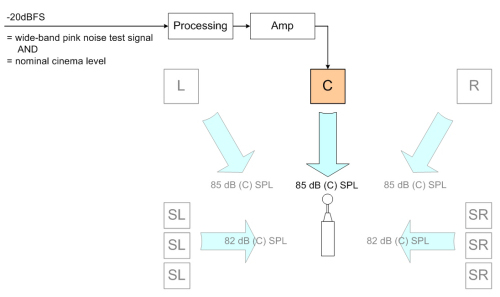 |
| SPL at L, C, R = 85dB(C), SPL at SL, SR = 82dB(C) [-3dB for 'mono' surround channels] |
LFE: A separate low frequency channel was introduced to reproduce special low frequency content especially for movie production. This LFE channel (Low Frequency Effects) has normally a bandwidth of 20Hz up to 120 Hz. It should not be used for the entire low frequency content of the multichannel sound presentation. The left and right channel are equipped with their own independent subwoofer systems. The LFE channel should only carry the additional low frequency enhancement information. (In contrast for home cinema systems the bass management system in included to mix the sub-frequency content of all channels into the subwoofer channel.
![]() See: Surround-Sound.)
See: Surround-Sound.)
The LFE channel is different from any other of the five surround channels and is recorded with a level offset of 10dB (recommendation ITU-R BR.1384). Why 10dB lower? With old magnetic oxide tapes for surround movies the level for the LFE channel was brought down by 10dB to not overload the recorded LFE track, improving the low-frequency headroom on the film. The 10dB level offset was turned up again in the cinema processor to compensate for the difference. This approach was possible because the high cut filtering eliminates any hiss or higher frequency noise that would be introduced by the additional level gain.
With digital recordings and signal transmission (Dolby Digital) the bandwidth of the LFE ".5" channel is only 1/200th of the main channels sample rate. The sample rate is 240Hz for the 120Hz signal bandwidth for a 48kHz sample rate for the main channels.
For any bass management system or bass management programming in the audio DSP system for home cinema or any semi-pro system it must be kept in consideration that the incoming LFE channel signal is always 10dB lower than the sub-frequency content of the main channels.
Subwoofer Main Channels: The main channels left, center, right are normally equipped with additional subwoofers that belong to these channels and are completely independent from the LFE channel and from each other. They reproduce the individual low-frequency content of these channels. Only in home cinema or semi-pro installations these subwoofer signals are combined to one subwoofer channel via the bass-management (see below).
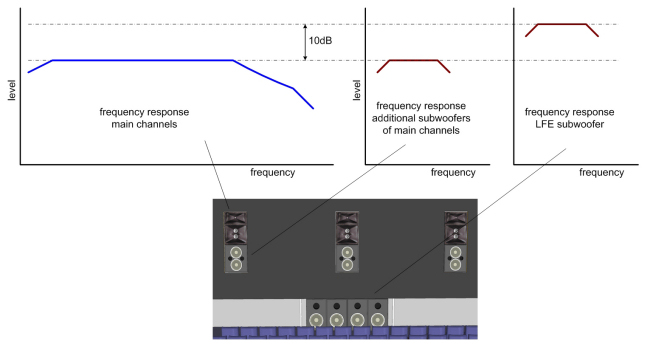 |
| subwoofers as extension to the main channels and the 10dB level difference between main channels and LFE subwoofer channel to compensate for the 10dB difference of the LFE signal in the signal supply chain measured with wide-band pink noise |
Because the LFE material is by definition only the low frequency effects material (explosions etc.), the low frequency content of the regular stereo signals should be reproduced by the main stereo loudspeakers. This is a generally so in cinema systems but for home cinema a different approach is used. With a proper bass management system all low frequency content of all channels can be fed into the subwoofer channel. This subwoofer channel is not a LFE channel anymore but a reproduction channel for all low frequency content, it carries the low-frequency content of all five channels plus the LFE content. Because of psychoacoustic reasons the position of the low-frequency content is difficult to localize and the splitting and mixing into one channel will not be recognized. With bass management the low frequency range for the content of the regular five channels must be properly defined (bandwidth, level, crossover frequency).
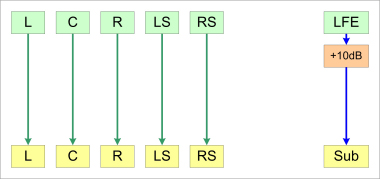 |
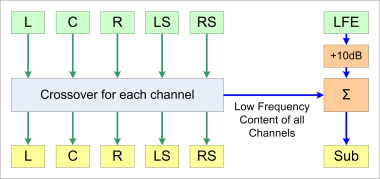 |
| LFE channel without bass management | bass management for all channels |
The surround speaker channels are set individually to -3dB compared to the master channels because the acoustical sum of both surround channels adds up to 0dB if the content is equal. This has its historical cause because the surround channel was originally a mono surround channel with correlated signal for both surround speaker channels, adding up for 3dB at listening position between the two speaker channels. This is only executed in cinema settings. Home cinema systems follow the recommendation of ITU-R BS.775-2 with all five speakers set to the same level. The IRU approach is fitting to modern formats with two individual and therefor decorrelated surround channels which don't add up to a 3dB level raise. The coverage of the surround speakers should be within +/-2dB uniformly over all seating area.
Surround speakers must provide uniform coverage of all audience. Here the spacing between speakers, height above floor and aiming angle are important.
There are two basic designs for surround speakers: dipoles and direct radiators. Dipoles distribute sound in both directions forward and backward in parallel to the walls. This can create a very even sound distribution. Direct-radiating speakers project sound in the forward direction.
In todays movie theatres seats are often placed very close to the surround speakers to maximize the seating area. Because of the necessary dry room acoustics this can cause localization of the loudspeakers rather than to hear the proposed diffuse sound field.
These circumstances and the high output levels needed can only be compensated by a higher number of speakers and grouping surround speakers closer together.

In cinema installations no single surround speakers on each side wall are used but an entire set of speakers covering the side and real walls. This is necessary because unlike in music listening situations the entire audience in a cinema can not sit in the 'hot spot' (or only a few tickets would be sold ..). By using a set of surround speakers on the side and rear walls surround sound and ambience impression can be provided for the whole audience except a few uncomfortable positions in the very front and the extreme side seats where the signal from the other side cannot be heart.
Because of limitations in the analogue transmission path for cinema audio initially only one surround channel could be provided that was matrixed within the two-channel signal but with the upcoming digital signal distribution six discrete channels could be implemented: Dolby Digital 5.1.
In 1998 the Dolby Digital Surround EX was introduced, a joined venture between Dolby and Lucasfilm THX, to give movie producers the ability to differentiate between left, right and rear surround signals.
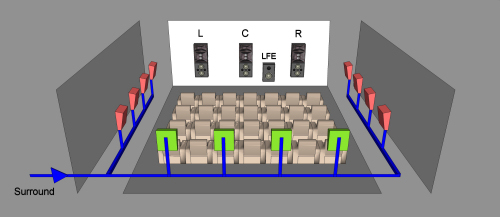
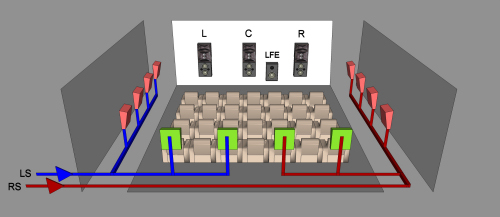
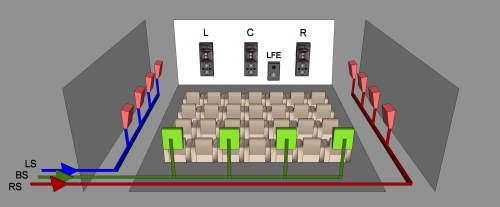
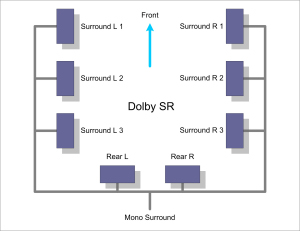 |
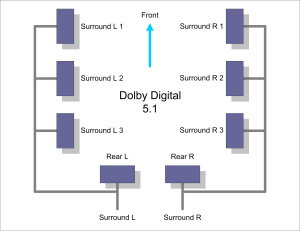 |
| Dolby SR (one surround channel) | Dolby Digital 5.1 (two surround channels) | 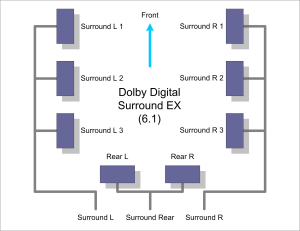 |
 |
| Dolby Digital Surround EX (three surround channels) | Surround 7.1 (four surround channels) |
Not jet used in movie theatres as surround loudspeakers are smaller line arrays (larger column speakers). The characteristic of these systems could create a smoother coverage from over the entire audience area without being localized...
In Home Cinema the 7.1 Surround format features four surround channels. Surround receivers create a 7.1 mix with four surround channels out of the original 5.1 movie mix supplied by a DVD to produce a more impressive surround sound experience.
In professional cinema the eight channels surround setup consist of five front channels and two surround channels. The most prominent professional format for this setup is Sony's SDDS Format (Sony Website).
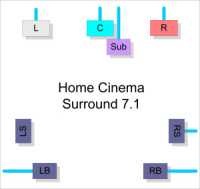 |
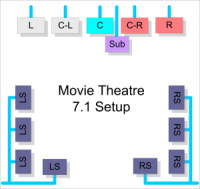 |
| Home Cinema 7.1 Surround | Eight-Channel Cinema Surround with Center-Left and Center-Right |
Movie theatre screens are always perforated to enable the speaker positions behind the screen. Today a micro-perforation in accordance with high definition picture standards.
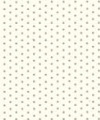 | micro perforation of a movie theatre screen (here Gerriets 'Gammalux Micro') with 300,000 holes per square meter and about 6% open surface, color: plain white |
The masking system around the screen (black material) must also be acoustically transparent because for smaller movie formats the material can cover the left and right loudspeakers.
Despite the ITU standard with 30 degrees listening angle for the left and right speakers, for cinema monitoring a different setup is used. The front left and right monitor speakers are angled by 22.5 degrees each to complement the listening situation in the best cinema seats with an viewing angle of the Cinemascope screen of 50 degrees (25 degrees each side).
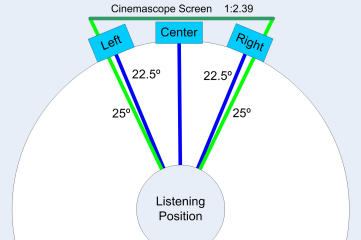
For the surround channels in cinema monitoring often a set of smaller surround speakers is used similar to the real setup in a movie theatre.
THX Ltd was established in 1983 by the George Lucas company with the purpose to create standards to correct inadequate movie playback in cinemas.
" ..is the founder of quality assurance programs for superior cinema presentation.." (from the THX Website)
THX Website: "A THX Certified Cinema is built from the ground up, taking extra steps, often times installing additional materials and equipment, to create an environment that will totally immerse you in the story. Whether you’re on a first date, going for a blockbuster opening night, or catching a matinee, get ready to experience the magic and emotional impact created by the director for you to enjoy."
See THX.